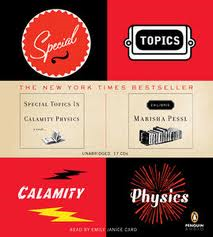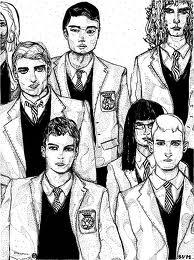An appreciation of the printed word (hopefully even printed on paper and bound together with a decorative cover) is a dying concept. We hope to, slowly but surely, rectify this tragic situation by introducing and discussing works, both fiction and nonfiction, modern and classic, that we feel warrant purchasing/ checking out from your local library. In other words, You Gotta Read This! This regular feature will be mainly spoiler-free. I will simply be providing a plot synopsis and the reasons this work warrants reading.
In honor of the upcoming release of Marisha Pessl’s second novel, Night Film, I thought it would be fitting to review her first novel, Special Topics in Calamity Physics.
“It’s kind of funny…the moments on which life hinges. I think growing up you always imagine your life—your success—depends on your family and how much money they have, where you go to college, what sort of job you can pin down, starting salary…But it doesn’t, you know. You wouldn’t believe this, but life hinges in a couple of seconds you never see coming. And what you decide in those few seconds determines everything from then on… And you’ll have no idea what you’ll do until you’re there.”
-Marisha Pessl, Special Topics in Calamity Physics

Equal parts coming-of-age story, murder mystery, and college thesis, Marisha Pessl’s Special Topics in Calamity Physics frequently finds itself classified as literary fiction. It’s not an entirely unfair assessment, as it name checks literary works from everyone from Shakespeare to Bronte to Kafka to Ginsberg to de Sade, but to call it that undermines how sharp the novel is and how much fun Pessl is having with her creation.
At the center of the novel is Blue van Meer, a well-read, articulate, Harvard freshman, writing a scholarly essay (complete with citations of both fictional and non-fictional works) examining her senior year at an elite high school. Much of Blue’s existence is characterized by brief stays in various towns and schools, as dictated by her father’s schedule. Her father, a highly respected, highly pretentious, vaguely lothario, professor transports her from place to place, discussing with her topics ranging from philosophy and economics to old world Hollywood scandals. Newly arrived, Blue finds herself taken under the wing of Hanna Schneider, a film teacher at the school who seems to hold the access keys to the most popular clique, known appropriately enough as the Bluebloods.

The novel also has animation. Pictured here: The Bluebloods
As Blue becomes further intertwined in the world of Hannah and the Bluebloods, she finds herself distancing herself from her father’s influence and becoming more and more ingrained in a world in which she feels she does not truly belong.
Novels with unfolding narratives relating to precocious, outsider narrators and how they find themselves are hardly ground-breaking. They’ve been literary staples since the 19th Century. However, from the outset, Pessl makes it clear that nothing is exactly as it seems. Hannah died on a camping trip, with Blue and her fellow Bluebloods, whether by her own hand or someone else’s, and Blue still finds herself haunted by events of her recent past. The entire novel (and therefore her entire literary exercise) exists as an attempt to objectively examine that critical year and put the pieces of her life—and the moment her life irrevocably changed—into some semblance of order. There are no friends to assist her, no scholarly father to guide her, and she must face the demons and revelation of her past alone. Pessl titles each chapter after a literary work, be it Deliverance, The Woman in White, Metamorphosis, or The Big Sleep, and each title indicates some thematic significance. She has basically structuted her novel like an advanced readings class. However, what makes the novel such a joy (or irritation, depending on your view)is Pessl’s playful way with similes and narrative twists. We begin with one style of novel, but we end in an entirely unexpected place, and a multiple choice final exam to allow for further contemplation. It’s a novel that feels both fresh and familiar and practically sparkles with vitality, wit, and verve.
I’ll admit, this novel will either captivate or send you fleeing in frustrated disgust. It features a narrative both loopy and carefully constructed and a narrator and set of supporting characters that feel intriguingly elusive or just thinly drawn. Pessl endured a fair bit of criticism and resentment from the literary world for the large advance she received for this, her first novel. Many speculated it had more to do with her photogenic nature that would be gracing the novel’s back cover, rather than any literary value.

Don’t hate her because she’s both beautiful and scarily talented. Gosh, that seem really unfair, though.
The criticisms were unwarranted as novel received mostly positive reviews, and was named one of the “10 Best Books of 2006″ by the New York Times, and I tend to side with their assessment. I found the novel to be one of the most joyful, intellectually stimulating reading experiences I’ve had in quite a while. I may, as an English major, be predisposed to love such a work, but I though Pessl’s writing style was wondrously inventive and her plot machinations excitingly twisty and unpredictable. It was one those wonderful, tragic reading experiences you savor while it’s there and mourn the moment it ceases and the final page is read.
Special Topics in Calamity Physics is available on eReaders and in book stores everywhere. Marisha Pessl’s second novel, Night Film, will hit bookstores and the digital download market August 20th.
So, what do you think? Have you read Special Topics in Calamity Physics? Are you a fan? Do you hate it? Let us know in the comments!

